Poland Syndrome: Cause, Symptoms, Diagnosis, Treatment
What is Poland syndrome?
Poland syndrome is a disorder in which affected individuals are born with lacking or underdeveloped muscles on one side of the body, resulting in abnormalities that can affect the chest, shoulder, arm, and hand.
more common one side of the body is affected.
It is a rare condition. This syndrome is uncommon but can be present at birth. Poland syndrome is more common in boys compared to girls, and the right side is affected twice as often as the left side is affected. The reasons for this have not been definitively exposed.
it is characterized by the lack of chest wall muscles and webbing of the fingers(syndactyly) of the hand on the same side.
it is also called Poland sequence, Poland anomaly, Poland syndactyly, and absence of the pectoralis muscle with syndactyly.
The muscle involved in Poland syndrome
- Origin: Clavicular head: anterior surface of the medial half of the clavicle bone Sternocostal head: anterior surface of sternum, Costal cartilages of ribs 1 to 6 Abdominal area: Anterior layer of the rectus sheath
- Insertion: Crest of the greater tubercle of the humerus or Lateral lip of intertubercular groove of the humerus.
- Action: Shoulder joint: adduction of the shoulder, internal rotation of the shoulder, flexion of shoulder, (clavicular head), arm extension (sternocostal head); Scapulothoracic joint: Draws scapula anteroinferior
- Innervation: Lateral and medial pectoral nerves (C5-T1)
- Blood supply: Pectoral branches of the thoracoacromial artery, branches of the internal thoracic artery
Pectoralis minor
- Origin: Anterior surface, costal cartilages of ribs third to five.
- Insertion: Medial border and coracoid process of the scapula (shoulder blade).
- Innervation: Medial and lateral pectoral nerves (C5 – T1).
- Blood supply: Thoracoacromial artery (pectoral and deltoid branches), superior thoracic artery, lateral thoracic artery.
- Function: Scapulothoracic joint: pull scapula anteroinferior and stabilizes scapula on the thoracic wall.
Epidemiology
This syndrome is often underdiagnosed and under-reported, the exact incidence is not definitively known, and incidence rates are usually estimated. this syndrome affects males three times as often as females and affects the right side of your body twice as often as the left.
What are the Causes of Poland syndrome?
The exact cause is unknown in Poland syndrome. It may be from a blockage of blood flow to the chest, shoulder, arm, and hand muscles while a baby is developing in the womb(before birth). At this stage of the gestation period, the fetus is dependent on blood flow for development. This syndrome could present itself when there is an interruption of blood flow to tissues around the chest and ribcage.
In the rare case of Poland syndrome is caused by hereditary changes it can be passed down in families, but no related genes have been identified. Poland syndrome is also referred to as Poland sequence on occasion because there is a pattern of abnormality detected from the primary defect. this syndrome is believed to be tied to impaired development of a specific artery or other interrupted blood flow during embryonic development. The specific pattern of the defects is believed to depend on the site and the amount of diminished blood flow.
What are the Signs &Symptoms of Poland syndrome?
These signs and symptoms may be different from person to person. Some people may have more symptoms compared to others. Signs and symptoms can range from mild stage to severe stage. there are different symptoms, it depends on the severity of the condition. A person with this syndrome may have all, or some, of the following symptoms, usually on one side of the body.
Some signs & symptoms of the condition may include :
- Underdeveloped or missing upper rib cage.
- hypoplasia of chest muscles.
- lack of shoulder muscles.
- Abnormal ribs or underdeveloped or missing ribs sometimes can lead to breathing problems.
- lack of the chest muscle in the pectoral area.
- Missing or abnormally placed underarm hair.
- Hand abnormalities such as shortened or fused fingers.
- Abnormally shortness of fingers(brachydactyly) and webbed of fingers(syndactyly).
- Underdeveloped ribcage.
- Unusually elevated or underdeveloped shoulder blade (scapula).
- Shorter fingers on one side of the hand are always on the same side as the affected part of the chest muscle.
- Abnormally small hand or shorter forearm on one side.
- Underdeveloped breasts in women.
- missing or lack of breast, nipple, and areola (the pink or brown skin surrounding the nipple) on the affected side.
- Patchy underarm hair growth.
- A chest shape that appears to curve is inward, rather than outward.
- Short, possibly webbed fingers.
- Missing armpit hair.
- Rarely heart, lung, or kidney problems abnormalities in this syndrome.
How is Poland syndrome Diagnosed?
- Poland syndrome is diagnosed through the physical examination and The doctor will also arrange for specialized tests to confirm the diagnosis such as CT scans(computerized tomography), MRI(magnetic resonance imaging), and X-rays. CT scans and MRIs help tell your doctor which specific muscle groups are affected.
- The diagnosis is during the physical exam, the doctor will look for signs of this syndrome. they will also ask you when you noticed the signs&symptoms.
- underdeveloped or missing fingers may be noticed first.
- The diagnosis of this syndrome is usually made at birth based upon the characteristic physical findings, a thorough clinical evaluation, and a variety of specialized tests(computerized tomography (CT Scan), X-rays, and magnetic resonance imaging (MRI) )
- CT scan( computerized tomography) can determine the extent to which the muscles may be affected.
- X-ray studies may be used to help for determining and characterize particular results and abnormalities that can affect the shoulder blades, ribs, forearms, and hands.
- MRI(magnetic resonance imaging) studies may be utilized to delineate the anatomy of the involved area.
Some other tests may prefer by the patient such as:
- blood tests
- chest X-ray
- electrocardiogram (ECG) to test heart function
- pulmonary function tests to check the lungs
- genetic testing to look for related syndromes
Differential diagnosis
- Chest wall anomalies,
- Breast/nipple anomalies,
- Isolated thoracic lipoatrophy,
- Isolated hand/upper limb abnormality without pectoralis major muscle involvement.
- Syndromes rarely associated with PS include Moebius,
- Klippe Feil,
- Pierre-Robin,
- Sprangle deformity
- Carey-Fineman-Ziter.
What is the complication of Poland Syndrome?
Sometime Sprangel deformity conditions can develop. this causes a lump at the base of your neck from an elevated shoulder blade( it means a large, flat bone on both sides of your back below your shoulder can that helps to increase the range of movement of your arm). It is important to proper treatment of this syndrome to help prevent disability. Over time, the condition can significantly diminish your movement on one side of your body. For example, you might experience difficulties picking up or reaching for an object. this syndrome can also limit your range of motion. Rarely, this syndrome can cause spinal health complications. It may also lead to kidney problems. Severe cases may lead to a displacement of the heart on the right side of your chest.
How is Poland Syndrome Treated?
Medical treatment
- Reconstructive(Plastic) surgery is the most common treatment for this syndrome.
- Poland syndrome treatment will be based on how much severity of this condition is it.
- Types of treatment include: implants or injections to fill out the underdeveloped the chest area
- If chest-wall ribs are underdeveloped or lacking, bio-engineered cartilage can be implanted to help give the chest a more normal appearance.
- hand surgery is to create the most useful hand
- surgery on the ribs to help with breathing difficulties.
- Plastic surgery may be performed to help rebuild the chest wall and to graft ribs into their proper places. In women, surgery may also be performed to construct a breast mould. In some cases, surgery may also be performed to help correct skeletal deformity affecting other body areas such as the hands. Physiotherapy may also be prescribed to help improve any limitations of the range of motion.
- Reconstructive(Plastic) surgery may be considered in males as young as 13 years of age. In females, to ensure breast similarity in size and character, reconstructive surgery is often postponed until the breast developed on the uninvolved side has been completed.
- Therapeutic tattooing can be helpful to create the appearance of an areola and nipple.
Physiotherapy Treatment
- Improve muscle strength
- Improve range of motion
- Improve chest mobility
Post-operative physiotherapy treatment
- For Reduce pain and inflammation
Electrotherapy
- Ultrasound: Therapeutic Ultrasound therapy is used to decrease pain as well as swelling. One of the therapeutic effects for which ultrasound has been used is tissue healing and removal of the scar.
- Transcutaneous electrical nerve stimulation(TENS): This modality is used the reduced pain as well as inflammation.
- Deep heat therapy: Use to reduce pain.
Exercise therapy
- Deep Breathing Exercises: These exercises are an effective starting point to help open up your airways. An effective position is to lay on your back. If you place your hands on the outside of your middle ribcage, this can help with the feedback as to where you want some of the air to flow. A general technique is as follows (you are of good health). Take a large, deep breath(inhalation) through the nose. Hold to 2 seconds. Then release slowly breath out of the mouth. Performing 10 repetitions of this is a starting point to work on your deep basal expansion. It can also be a great way to unwind after a long day at work.it is also helpful for the improve ventilation.
chest stretching exercise
chest stretching exercise is helpful for the improve blood flow.
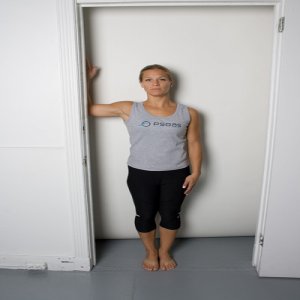
(1) Doorway Pectoral Stretch:
- In a standing position, With the help of a doorway, you can easily be stretching your pectoral muscles.
- Stand in the mid of a doorway with one foot in front of the other.
- flex your elbows at a 90-degree angle and place your forearms on each side of the doorway.
- Stand in an open doorway and approximately 6 inches facing away from a doorway, Raise each arm to the side, bent at 90-degree angles with palms forward. Relax your palms on the door frame.
- Slowly step forward with one foot. Shift your weight onto your front leg, and bent forward until you feel a stretch in your chest muscles. and Feel the stretch in your chest muscles and shoulder muscles. Stand upright and don’t lean forward.
- Slowly extend your mid-section away from the door to feel the stretch in your chest muscles (You will feel a secondary stretch in your biceps)
- Hold for stretch 10-30 seconds Step back and relax.
- Relax and return to the starting position.
- Repeat these steps 2-3 more times on each side 2 times per day or as instructed.
(2) Camel pose
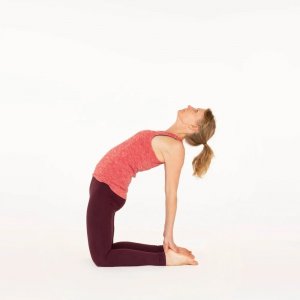
- The usual starting position for Camel Pose is kneeling on the floor or yoga mat.
- In this pose Kneeling position with the body upright and hips stacked over the knees. Use Take padding (a blanket or fold your mat so it is double thick) under your knees if they are sensitive.
- Draw your hands up the side of your body until your palms extend the sides of your rib cage. Let your thumbs rest on the back of the ribs as the other 4 fingers wrap around the sides and fronts of the rib cage with elbows pointing out. With this hold, use your hands to lift the rib cage for support as you start to open your chest toward the ceiling.
- Maintain your chest position as you reach your hands back one at a time to hold your heels. If you need a little more height, push your toes under. then, the tops of the feet can be flat on the floor.
- Take your hips forward so that they stay over your knees.
- If it feels good, let your head come back, and open your throat. If that does not work for your neck, you can keep the chin tucked instead.
- Release by bringing your chin close to your chest and hands to your hips. support your lower back with your hands as you slowly bring your body to an upright kneeling position.
- Hold for 15-20 seconds.
- Relax and return to the starting position.
- Repeat these steps 2-3 more times on each side 2 times per day or as instructed.
- Benefits of camel pose: This Pose stretches the front of the body including the chest, abdomen, and quadriceps. This pose helps improve spinal mobility as much of the day you are likely to be sitting or slouching and bending your spine forward. By doing a backward bending, you are flexing it in the opposite direction and it may help you develop better posture.
(3) Towel or strap Chest Stretch
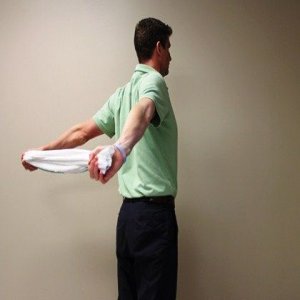
- Tight pectoral muscles can result from not good posture, weight lifting, or simple daily activities. You can stretch your pectorals and keep them flexible using a towel or strap, though there are other variations.
- An injury to one or both of your pectoral muscles may cause you to lose shoulder range of motion (ROM) and overall function around your arms or chest.
- To prepare, get a long towel or beach towel. If you do not have a towel, just use a belt or a strap. Breathing normally as you stretch.
- While standing position with good posture and holding a towel at both ends, lift your arms overhead and then allow your arms to fall behind your neck and back.
- Lift the towel behind, holding both ends with both hands. to keep your arms straight.
- You should feel some slight rotation movement in your shoulders.
- Use the towel to gently draw your shoulders into extension. You should sense a stretch in the front of your chest. compress the shoulder blades together to maximize the stretch.
- Hold this position for ten to twenty seconds, and then relax.
- Remember to breathe slowly and let the pectoral muscles stretch gently.
- The closer you hold your hands to the towel the stronger the stretch will be. the distance of your hands properly to find a good stretch.
- Slowly back to the normal position and rest for 2 to 5 seconds.
- You can repeat the stretch 3 to 5 times, a few times a day.
- Benefits:
- Keeping your pectoral muscles flexible can help make it easier for you to attain and maintain proper posture. Since the pectoral muscles can help move the shoulder and flexible chest muscles can ensure that you retain full mobility in your shoulder joints with no limitations.
- pectoral muscles attach to the sternum bone (breastbone) and then course to the front of each shoulder. The muscles help draw your shoulders in and across your body, a motion known as horizontal adduction.
- Injury to your pectorals may cause you to lose the ability to fully adduct your arms, leading to difficulty with lifting and pushing activities. Stretching your pectorals is one component of rehabbing your pectorals to helpful for you regain normal mobility.
(4) Behind-the-back Elbow-to-elbow Grip
- To perform is a great way to stretch any time of the day. While doing this exercise uses the mat.
- In a sitting position or standing position, start with arms hanging by your sides and shoulders pressed down away from your ears.
- Gently compress your shoulder blades together and broaden the chest. Bring the arms behind the back and grasp the elbow to elbow.
- Hold for each stretch for 15 to 30 seconds or 3 to 5 breath cycles. One breath in + one breath out = 1 breath cycle.
- Avoid bouncing. With each breath out, move into the stretch a little further, but only to the point of tightness, or slight discomfort, never pain.
- Perform stretches 2 to 4 times.
- Bring focus to pull the shoulder blades downward and back, while also shining your chest and heart forward to create length within the pectoral muscles.
(5) Above-the-head Chest Stretch
- This is another stretch that can be performed either sitting or standing. Play around with the positioning of the hands to emphasize the shoulders and/or chest. While doing this exercise uses the mat.
- In a sitting position or standing position, interlock your fingers, bend your elbows and raise your arms above your head.
- Gently squeeze your shoulder blades together and move your elbows and hands back.
- Vary the height of your hands to stress shoulders and/or chest (hands behind head, hands on top of head, hand a few inches above head)
- Hold for each stretch for 15 to 30 seconds and 3 to 5 breath cycles. One breath in + one breath out = 1 breath cycle.
- Avoid bouncing. With each breath out, move into the stretch a little further, but only to the point of tightness, or slight discomfort, never pain.
- Perform stretches 2 to 4 times.
- Bring focus to pull the shoulder blades downward and back, while also shining your chest and heart forward to create length within the pectoral muscles.
(6) Bent-arm Wall Stretch

- This exercise allows you to stretch the side of your chest separately. While doing this exercise uses the mat.
- Assume a split stance, Right leg is in the front of the left leg in the back, at the end of a wall, or in a doorway.
- Take the left arm up to shoulder height and position the palm and inside of the arm on the wall surface or doorway.
- Gently push a chest through the open space to feel the stretch.
- Moving the arm higher or lower will allow you to stretch various parts of the chest.
- Repeat on the other side.
- Hold for each stretch for 15 to 30 seconds or 3 to 5 breath cycles. One breath in + one breath out = 1 breath cycle.
- Avoid bouncing. With each breath out, move into the stretch a little further, but only to the point of tightness, or slight discomfort, never pain.
- Perform stretches 2 to 4 times.
- Bring focus to pull the shoulder blades downward and back, while also shining your chest and heart forward to create length within the pectoral muscles.
(7) Extended Child’s Pose on Fingertips

- A woman wearing a bright blue tank top, black running pants, and red shoes are in an extended child’s pose on her fingertips.
- While doing this exercise uses the mat.
- In yoga, the child’s pose is considered a resting exercise, but when the arms are extension position, this exercise becomes very active in the upper body while still providing stress relief to the low back.
- Kneel on the floor. Touch your big toes together and sit on your heels, and after that separate your knees about as wide as your hips.
- Bend move forward from the hips and walk your hands out as far in front of you as possible. With the arms extended and palms facing down, come up onto the fingertips as if you have a ball underneath your palms and melt the chest facing the floor.
- Hold for each stretch for 15 to 30 seconds or 3 to 5 breath cycles. One breath in + one breath out = 1 breath cycle.
- Avoid bouncing. With each breath out, move into the stretch a little further, but only to the point of tightness, or slight discomfort, never pain.
- Perform stretches 2 to 4 times.
- Bring focus to pull the shoulder blades downward and back, while also shining your chest and heart forward to create length within the pectoral muscles.
(8) Side Lying Parallel Arm Chest Stretch

- This exercise allows you to target each side of the chest individually and give special attention to the shoulders. While doing this exercise uses the mat.
- In a Lying prone position on your stomach, bring both arms out to the sides, palms facing down, to create the letter, T.
- Start to roll onto your right side by pressing yourself with your left hand. Lift the left leg, bend the knee and place the left foot behind you on the floor for stability purposes. Relax your right leg on the ground.
- Keep the left hand on the floor for balance and For an extra stretch, lift the left hand toward the ceiling.
- Repeat on the other side.
- Hold for each stretch for 15 to 30 seconds or 3 to 5 breath cycles. One breath in + one breath out = 1 breath cycle.
- Avoid bouncing. With each breath out, move into the stretch a little further, but only to the point of tightness, or slight discomfort, never pain.
- Perform stretches 2 to 4 times.
- Bring focus to pulling the shoulder blades downward and back, while also shining your chest and heart forward to create length within the pectoral muscles.

(9) Chest Opener
- chest opener stretch
- grasp hands behind your back. Squeeze shoulder blades together. For more stretch lift your hands off your back.
- Hold each stretch for 15 to 60 sec.
- Repeat 2 to 4 times.
(10) Foam Roller Chest Stretch
- Lying position on foam roller, relax shoulders and arms out to your side.
- Hold each stretch for 15 to 60 sec.
- Repeat 2 to 4 times.
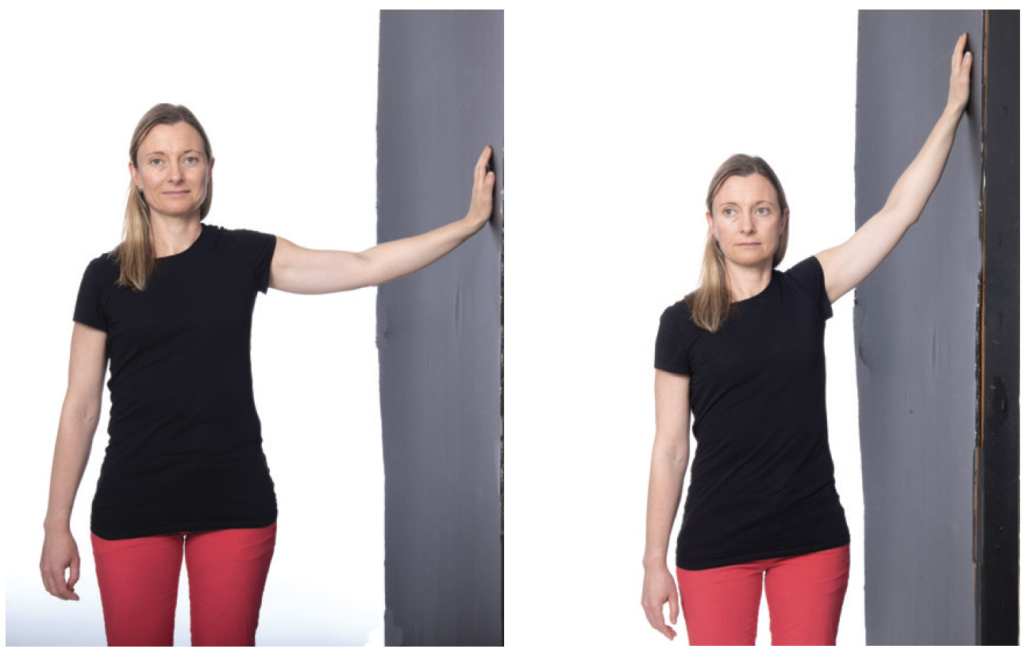
(11) Walk Up The Wall
- walk up the wall chest stretch
- Begin with your hand at shoulder height and gradually walk your hand up the wall until you feel a stretch.
- Repeat on the opposite side.
- Hold each stretch for 15 to 60 sec.
- Repeat 2 to 4 times.
(12) Back Bend Stretch
- In the Sitting position or standing position and take your hands to the back of your head. Point your elbows out to the sides of the space(room).
- Allow your head to fall back into your hands as you open your chest and compress your shoulder blades together.
- breath in and breath out deeply as you hold, pressing your chest upward. hold for 20 to 30 sec. repeat 2 to 4 times
(13) Lying Chest Stretch
- Lying on your stomach on a workout mat. extend your arms to the sides of the room to create a T shape with your body.
- Bring your left hand to your left hip as you slowly start to roll to your right arm extended on the floor.
- stop when you feel the stretch in the right side chest muscle and hold for 20 seconds.
- Repeat on the left side.
(14) Standing Chest Expansion
- Standing with your feet hip-width apart and soften your knees.
- Connect your fingers behind your tailbone.
- Push your knuckles toward the floor as you open your chest out and up.
- Hold for 30 seconds.
- repeat 2 to 4 times
(15) Stability Ball Chest Stretch
- In Lying with your back supported by a stability ball. Place your feet tightly on the ground, hip-width apart.
- Open your arms to the sides of the room and let them hang so you feel a stretch in your chest or pectoral muscles.
- Hold for 20 to 30 seconds.
- repeat 2 to 4 times
(16) Hands Behind the Back:
- In Standing tall with your feet shoulder-width apart. Intermixed your fingers behind your back and straighten your arms.
- Keep your chest lifted and draw your shoulder blades downward.
- Hold for fifteen to twenty seconds and repeat 3 times.
(17) Floor Angels:
- In a Lying position flat on your back with feet hip-width apart and flat on the floor.
- Floor angles Position both arms to the side at a 90-degree angle with the surface of the palm upward and toward the ceiling. Keep in contact with the floor at all times, and slowly take your arms up over your head until they are fully extended.
- Then slowly take both arms back to the 90-degree starting position.
- Repeat 10 times for 3 sets.
- Remember to keep your back flat against the ground and ribs tucked at all times.
(18) Shoulder Lateral Rotation Stretch
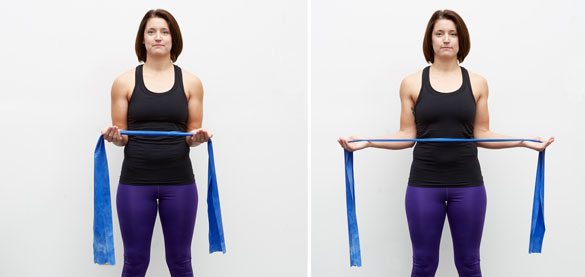
(19) Shoulder Flexion Stretch

(20) Anterior Shoulder & Chest Stretch:
- Muscles: Pectoralis Major, Pectoralis Minor, Anterior Deltoid, Biceps Brachii, Brachioradialis, and Brachialis
- Method: In Standing position next to a wall with one arm outstretched behind you parallel to the ground with your palm facing the wall. Slowly rotate or turn your body away from the wall. hold for 10 to 15 sec. and Repeat 2 to 4 times. Perform the both shoulder
(21) Pectoral Muscle & Anterior Shoulder Stretch; Shoulder Lateral Rotation Movement
- Muscles: Pectoralis Major, Pectoralis Minor, Anterior Deltoid & Serratus Anterior
- Method: In the Standing position next to a wall and place your palm and forearm flat on the wall so that your elbow is bent at 90 degrees. Slowly rotate away from the wall without moving your hand or forearm. hold for 10 to 15 sec. and Repeat 2 to 4 times. Perform the both shoulder
(22) In Kneeling position on the ground and take to the physio ball to the side of the chest you will be stretching. Place one hand on the ball and another hand on the ground in front of you so that you are in a tabletop position. The forearm of the arm on the ball should be about aligned(parallel) to the ground, the elbow should be slightly in front of the shoulder.
(23) Let the shoulder drop slightly down until you feel a stretch in the pecs. You can move the hand on the ball moving forward and backward as well as right and left. Try looking towards the arm on the ball, near the ground
(24) Once you feel the stretch hold that position breathing smoothly for twenty to thirty seconds.
(25) Thoracic Twisting
This stretching position is sitting on a chair or table.
This Thoracic twisting exercise can also be another way of stretching the thoracic region and loosening up your chest.
hold for 10 to 15 sec. repeat 2 to 4 times.
Perform to both sides.
Chest strengthening exercise
(1) Isometric Chest Squeeze
Stand tall with one foot slightly in front of another foot and a dumbbell in one or both hands. flex your elbows, bringing weights in front of your chest. Lift dumbbells so your elbows are slightly above your shoulders and squeeze weights together and hold.
(2) Standing Press
Stand tall with your foot shoulder-width apart and a dumbbell in one or both hands. flex or bend your elbows, bringing arms out to the sides to form two 90-degree angles. do the Maintain this position, take arms/weights in to touch. Return to start. This is one repetition.
(3) Standing Hands Above Head Stretch
Stand tall and hands place lightly on the back side of your head, fingers interlaced. Gently grasp shoulder blades together as you pull your elbows and hands back, and hold.
(4) Lying Dumbbell Chest Press
Lie faceup with knees are flex and foot flat on the ground. With a dumbbell in one or both hands, extended arms straight up, palms facing out. Slowly flex or bend the arms, lowering them to your side until your elbows nearly touch the ground. Reverse movement to return to start. This is one repetition.
(5) Lying Dumbbell Chest Fly
Lie faceup with knees bent and foot flat on the ground. With a dumbbell in one or both hands, extend arms straight up, palms facing in. Keep a slight flex or bend to the elbows, and lower your arms out to the sides of your body until your hands are about six inches off the ground. Slowly reverse or back to the movement to return and back to start. This is one repetition.
(6) Sphinx Pose
Lie face down with legs hip-width space apart and forearms on the ground. Press into forearms and lift head and the chest off of the floor as you squeeze thighs and buttocks, and press the pubic bone into the ground.
(7) Sitting Chest Stretch
Stand tall, with fingers interconnecting behind your back and near your buttocks. Keep your shoulder blades together and back straighten, and push your arms up until you feel the stretch.
(8) Lying Dumbbell Chest Press Variation Lie faceup with a dumbbell in one or both hands, palms in the front of the forward, and feet flat on the ground. Lift arms straight up so the dumbbells are aligned with the shoulders. Keep your left arm lifted, and lower your right arm down until your elbow is even with your shoulder. raise the right arm back up to start and then lower the left arm while keeping the right arm straight up. Lift the left arm back to start. This is one repetition.
(9) Inchworm to Pushup
Start standing with feet hip-width apart. ahead(forward) at your hips and place your palms on the ground. Walk your hands forward to become into a straight-arm plank. flex elbow and lower chest down to perform one pushup. Press back up to the high-plank and after then walk hands back in toward the feet and stand up. This is one repetition.
(10) Dumbbell Pullover
Lie faceup, holding one dumbbell overhead with one and the other hands. Press the weight over your chest, then slowly reach back over your head, and continue until when you feel a stretch. after that slowly pull the dumbbell back over your chest. This is one repetition.
Active assisted range of motion shoulder exercise
(1) Shoulder flexion
Hold a stick or cane or wand with both hands and straighten your elbows. Raise your arms towards the ceiling as far as possible. Slowly lower your arms back down.
Repeat with the other arm.
(2) Shoulder extension
Hold a stick(wand) or cane behind you with both hands. Lift both hands away from your back as far as you can.
Slowly lower your arms back down.
Repeat with the other arm.
(3) Shoulder abduction
Hold a stick(wand) or cane in front of you with both hands. Cup your hand over one end. Push your other arm out to the side.
Repeat with the other arm.
(4) Shoulder external rotation
Hold a stick(wand) or cane in front of you with both hands. Keep your elbows flex and tucked into your sides. Move the stick or cane as far as you can away from your body without moving your elbows.
Repeat with the other arm.
(5) Shoulder internal rotation
Hold a stick(wand) or cane behind you with both hands. Move the stick across your back towards your opposite side of the hip.
Repeat with your other arm.
(6) Circles
bend forward so your arm comes away from your body. Rotate the arm in a clockwise direction and anti-clockwise direction.10 repetitions on each side.
(7) Pendular movements across the body
(8) Pendular movements forwards and backward
(9) Shoulder elevation with pulley
Pull down with unaffected arm to lift affected arm up.
Hold 5 secs and Continue for 5 mins.
(10) Scapula with bracing
Grasp shoulder blades down and in towards the spine.
Hold 5 seconds and 10 repetitions
Active range of motion shoulder exercise
Increase movement at a shoulder joint, increase the function of the shoulder joint as well as the whole limb, increase movement efficiency, and decrease pain at the shoulder joint.
(1) Shoulder flexion
Shoulder Flexion is a movement that decreases the angle between the two parts of the joint is connecting.
If you reach your arms straighten and palms against your sides and raise your arms in front of your body to point your hands at something in front of you.
Shoulder flexion is 180 degrees is a normal range of motion.
This involves moving your arms from palms against the side of your body to the highest point you can lift your arms over your head.

(2) Shoulder extension
Shoulder Extension is a movement that increases the angle between the two parts of the joint is connecting.
If you hold your hands behind you think about putting something in your back pocket you’re practicing extension.
A normal range of motion for shoulder extension to the highest point you can elevate your arm behind your back starting with your palms next to your body is between 45 and 60 degrees.
(3) Shoulder abduction
Shoulder Abduction occurs when you have your arm movement away from the median of your body.

When you lifted your arm away from the sides of your body, it’s the abduction of your shoulder.
A normal range for abduction, starting with your palms at your sides, and a normal shoulder range is around 150 degrees.
your hand position is above your head with your arms straight.
(4) Shoulder adduction
Shoulder adduction occurs when you move your arm towards the median of the body.
If you hug yourself, your shoulders are adduction movement.
shoulder adduction is 30 to 50 degrees is a normal range of motion depending on flexibility and body composition.
If your chest or biceps are particularly muscular, it may be difficult to move your arms towards the inner side.
(5) Medial rotation

In medial rotation With your arms at your sides, turn your palms towards your body and flex your elbows 90 degrees so your hands are pointing in front of you. Keep your elbows against your body and move your forearms near your body.
Imagine your body is a cabinet, your arms are the cabinet doors and you are close the doors. This is medial rotation also referred to as internal rotation and the normal range of motion for a normal shoulder is 70 to 90 degrees.
(6) Lateral rotation
With your arms at your sides, palms facing your body, flex your elbows 90 degrees. Keeping your elbows against your body sway your forearms away from your body. This is lateral rotation also called external rotation and the normal range of motion for a normal shoulder is 90 degrees.
Home advice
- Rest
- use a hot or cold pack: cold pack assist to relieve inflammation or swelling
What are the Common Mistakes during stretching exercises?
The pulling motion should be gentle, not do the jerking exercise or jerky movement.
You should not feel pain while stretching. You need to stop when the stretch starts to pain. Stretching also give too much stress on the muscles. Avoid stretching the same muscles multiple times the day.
Do not stretch cold muscles. It is best to stretch after a warm-up and after getting out of a warm bath or shower, or at the end of an exercise routine.
If you feel the stretch more in your shoulder joint than in your pectoral muscles, which is the goal, change your arm position.
What are the Safety and Precautions for Poland syndrome?
You should feel the stretch in your chest, but you should not feel any pain. If the stretch causes any pain, stop it immediately you can go and see your doctor.
Remember to check in with your doctor before starting this exercise or any other exercise program to stretch your chest muscles. A few sessions with your physical therapist can help you identify which pectoral muscle stretches are best for your particular needs and/or your condition.
DISCLAIMER:
This article is intended or purposeful for your general informational purposes only and does not address particular circumstances. it is not a substitute for professional advice(or guidance) or help( or assistance) and should not be relied on to make decisions of any kind. A few or any actions you take upon the information presented in this article are strictly at your own risk and responsibility.

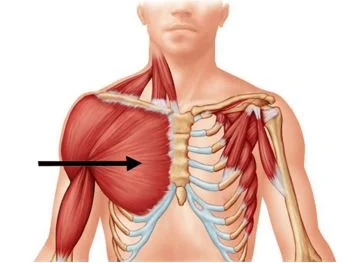
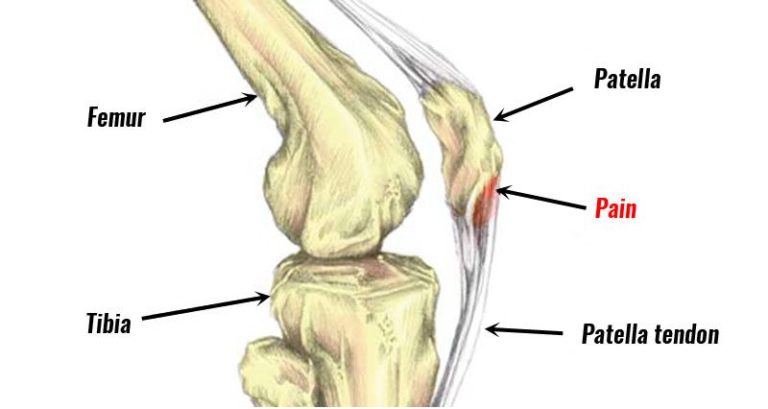
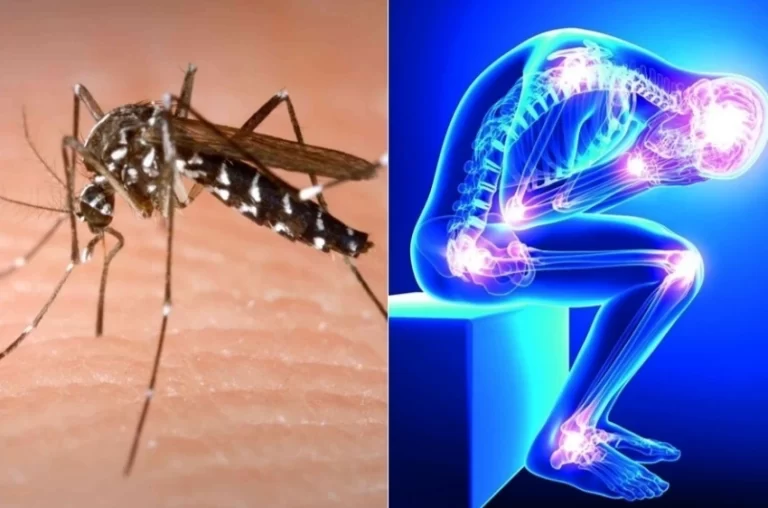
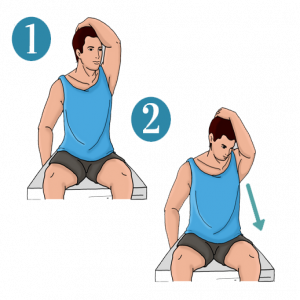
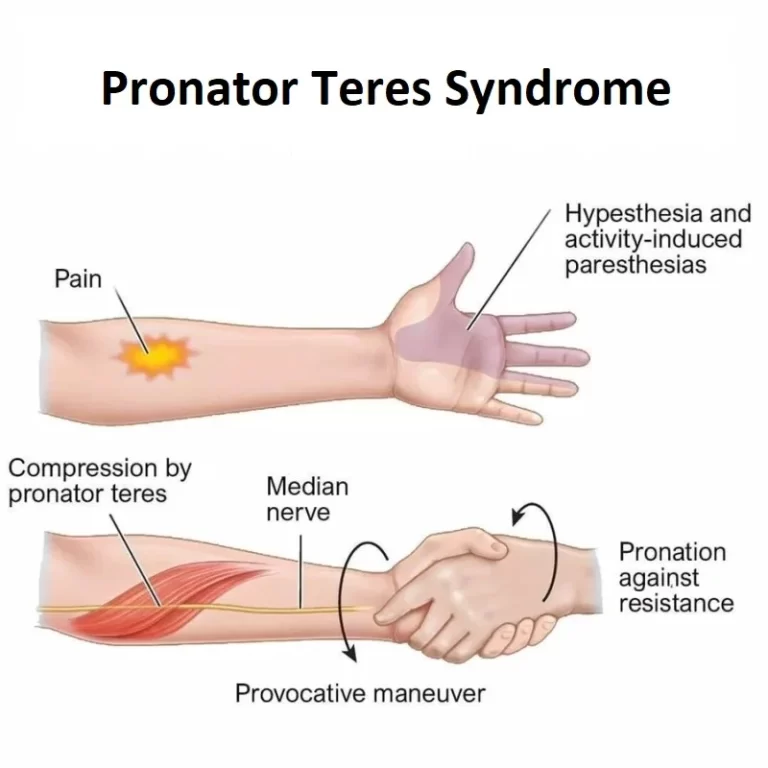
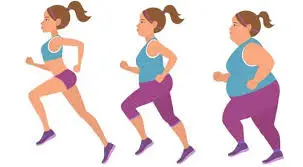
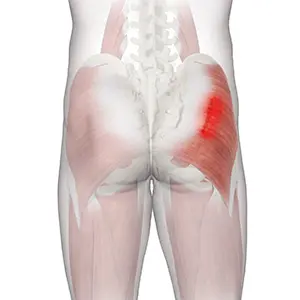
6 Comments